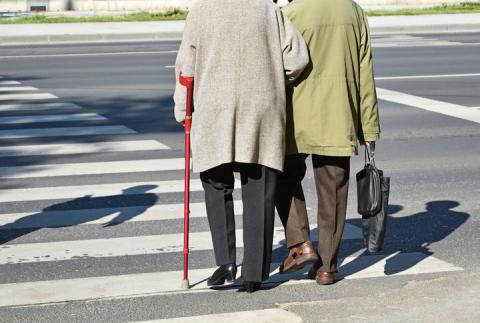Safer Walking for Senior Pedestrians
Why are senior pedestrians at higher risk of injury?
- Visual impairment makes it harder to navigate pavement, see cars, and judge the speed of a vehicle.
- Hearing loss also makes it harder to know that a car is approaching. Today’s almost-silent hybrid cars present even more of a challenge.
- Decreased physical mobility makes it hard to navigate uneven pavement and safely cross the street. And the attention needed to safely step off a curb means a senior may not see an oncoming vehicle.
- Cognitive changes or the side effects of some medications make it harder to judge whether it’s safe to cross a street, and to quickly react to unexpected hazards.
- Using a wheelchair or mobility scooter also raises the risk of a collision with vehicles. These assistive devices can make a pedestrian less visible, and a lack of curb cuts may force a user to cross the street in an unsafe manner.
What can our communities do?
Today a lot of research is underway about how to make our streets safer for older pedestrians. We should all advocate for senior-friendly walkways. Report walk signals that don’t provide enough time for a senior to safely cross. Call the city if broken pavement presents obstacles—or if a neighborhood with lots of seniors has no sidewalks. Attend planning meetings and contact your representatives to express how important safe walking is for the health and well-being of seniors.
Improvements such as curb cuts and designated crosswalks can make our sidewalks safer and more accessible for people of every ability. And traffic safety experts are experimenting with some high-tech solutions, such as sensors and apps. For example, in the Netherlands, seniors are testing a smartphone app they can use to increase the pedestrian crossing phase of the traffic signals.
Meanwhile, seniors (and, for that matter, all of us) can increase their safety by following these eight tips for safer walking:
- Practice “defensive walking.” Be on the alert for vehicles, especially at intersections and driveways. Even if you have the right of way, look both ways. And watch out for bikes, as well. Today more people bike, but cyclists may ride on the sidewalk or otherwise ignore traffic laws.
- Pedestrians have the right of way at crosswalks—but if a driver doesn’t see you or fails to stop, being in the right is small comfort. Stand at the edge so you can be seen, wait for cars to stop in both lanes, and make eye contact with drivers for extra assurance.
- Don’t text or talk on the phone while you walk—and be alert for other pedestrians who may be doing it. The American Academy of Orthopaedic Surgeons (AAOS) warns that this “distracted walking” can cause pedestrians not only to carelessly walk into traffic, but also to run into other pedestrians. The AAOS reports that seniors are the most likely to suffer serious injuries in these incidents.
- Know your route ahead of time. Avoid sidewalks with broken pavement, crosswalks that span several lanes, intersections where drivers make a lot of left turns, and crossings where you know the “walk” signal isn’t long enough for you.
- Take care walking through parking lots. Be alert for brake lights that can alert you that a car is backing out of a space.
- Don’t step into an intersection once the “don’t walk” signal is flashing. In many communities, it is illegal, and it may not allow you enough time to complete your crossing before drivers get the green light. If the crosswalk has a numerical countdown signal to tell how many seconds are left, don’t start to cross once that begins, either.
- Be seen! In low-light conditions, a pedestrian wearing dark clothing is practically invisible to drivers. Wear bright colors when out walking. Carry a flashlight at night. Even if orange isn’t your best color, a safety vest with reflectors makes you much more visible.
- Impaired walking can be just as dangerous as drunk driving. Don’t drink alcohol and walk. And, says the Governors Highway Safety Association, the legalization of marijuana seems to have led to more cannabis-related pedestrian injuries.
